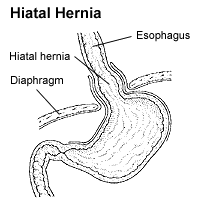
Photo from wikipedia
Hiatus Hernia (HH), with its anatomical/physiological derangement of esophagogastric junction (EGJ) barrier function is a risk factor for pathological gastro-esophageal reflux (GER). However, a subset of patients with HH do… Click to show full abstract
Hiatus Hernia (HH), with its anatomical/physiological derangement of esophagogastric junction (EGJ) barrier function is a risk factor for pathological gastro-esophageal reflux (GER). However, a subset of patients with HH do not have reflux. The aim of this study is to explore Lower Esophageal sphincter parameters and GER across the EGJ in patients with manometeric type C hiatal hernia (LES-Crural Diaphragm separation > 1cm, and Pressure Inversion Point below LES). An IRB approved, prospectively maintained esophageal testing registry was queried to identify patients who underwent High Resolution Manometry and 24h pH study (within 1 week) between 11/01/2016 and 11/01/2017. HRM characteristics of the EGJ (LES-CD separation, overall length, LESP, LESPI), 24 hour pH score, and pH < 4 holding time were extracted. Spearman's Rho correlation was calculated for all parameters and Receiver operating characteristic (ROC) curve was applied for parameters with significant correlation. A total of 1139 patients underwent HRM during the study period, of these 416 also had 24 hour pH study. 76 Patients met criteria for EGJ morphology Type C. After excluding patients with major disorders of peristalsis (16) the remaining 60 patients form the cohort of this study. Hiatal hernia size, overall length of LES, and LESPI did not correlate with 24 hour pH score or pH < 4 holding time. LESP had a significant negative correlation both with 24 hour pH score (R: -0.322; P = 0.011), and total acid holding time (R: -0.348; P = 0.006). A LESP cut-off value of 24.4 mmHg had a sensitivity of 53.8% and a Specificity of 91.2% for predicting pathological reflux. A higher LESP (> 24.4 mmHg) appears to provide an effective barrier to pathological GER even when normal EGJ function is compromised by a hiatal hernia. All authors have declared no conflicts of interest.
Journal Title: Diseases of the Esophagus
Year Published: 2018
Link to full text (if available)
Share on Social Media: Sign Up to like & get
recommendations!